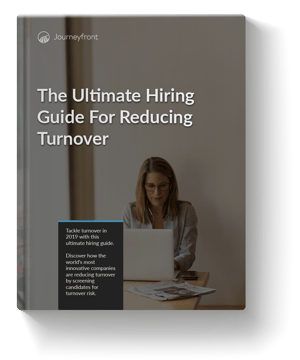There are a lot of things that need to go right for a new hire to eventually become a top performer. In most cases, employees typically don’t check every single box you’re looking for, but there are a select few that come very close. Maybe even a handful that check all your boxes. Once you find those unicorns, it’s imperative that you hang on to them. Every company is different, but it might be awhile until you find another!
Ensuring that you’re in a position to hang on to those top performers starts with understanding whether your star employees are entertaining other options. If there isn’t enough value being offered to incentivize them to stick around, they will inevitably start looking at alternatives. Don’t worry though, because below you'll find 7 Sure Signs Your Employee is Thinking About Turning Over, which will help you identify warning flags before it’s too late. This list will identify some of the less-obvious signs, rather than more obvious signs such as excessive absences, coming in late and leaving early, decreased quality of work, and changes in attitude.
1) Increase in Professional Network Activity:
A spike in online profile changes is a quick way to see if the employee is trying to be noticed by other companies in an effort to attract alternative opportunities. Are they sharing regular status updates? What types of things are they sharing on their feed? Have they made recent changes to their employment experience? In some cases, employees will even post their resume on different job boards, which is an obvious sign they might be in the market for a new opportunity.
2) Frequent Personal Calls:
When an employee is frequently engaging in personal calls during the day, the quick assumption would be that they’re actually taking time to entertain new job offers. However, this may also be an indicator that there may be a personal crisis of some kind going on the employee’s life. Don’t jump to conclusions. Take the necessary steps to try and identify why so many personal calls are being made, while still respecting the employee's privacy.
3) Life-Changing Event:
Sometimes employees aren’t entertaining alternative opportunities because they’re dissatisfied, but because there has been a major life-changing event, such as a pregnancy or an illness, in their life or the lives of family members. If the employee feels like the benefits at your company, such as compensation or healthcare options, aren’t sufficient to assist the employee through the life-changing event, they may look at other options.
4) History of Employees That Have Left:
Surely you’ve had top performing employees leave the organization before at some point. What were their reasons for leaving? Have those issues been addressed by your leadership team? Did that particular employee have a number of close friends on their team? If they were a leader among their peers you may be replacing more than one employee pretty soon if the issues have not been resolved.
5) Employee Becomes Isolated:
If an employee has one foot in and one foot out the door, it’s likely they will be less engaged with their coworkers. When employees make less of an effort to communicate and develop personal relationships with their teammates, it may be because the effort is not warranted since they plan on departing at some point soon. Go out of your way to engage the employee to see if they are resistant or disinterested.
6) Previous Job Tenure:
Sometimes determining whether an employee is entertaining other options can be as simple as looking at their job history. Do they have a track record of staying with a company long term? Or do they have a history of bouncing around from job to job? If the greatest indication of the future is the past, this will be a helpful place to look.
7) Friction Among Employees:
Employee’s butting heads can do a lot of damage to company culture and identity. Everyone wants to work with people they can enjoy and strained relationships between your top performer and a coworker is a problem that should be addressed right away. If the relationship is left to fester, you may lose a top performer.
It may seem like a tall order to keep your eye on all of these different things, but it’s still a lot less work than finding your next unicorn!
Enjoy this article? This is a small portion of our hiring guide "The Ultimate Hiring Guide for Reducing Turnover."
Click here to download the complete guide






